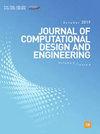基于改进SMOTE模型与CNN-AM相结合的轴承数据不平衡诊断方法
IF 6.1
2区 工程技术
Q1 COMPUTER SCIENCE, INTERDISCIPLINARY APPLICATIONS
引用次数: 0
摘要
提出了一种边界增强和高斯混合模型联合优化的过采样算法(BE-G-SMOTE),以提高不平衡轴承故障数据条件下的诊断精度。它旨在解决原始SMOTE模型生成的样本多样性有限的问题,以及深度学习模型受训练样本大小和处理速度的限制。首先对少量轴承故障数据进行G聚类,实现聚类划分;其次,根据本文设计的聚类密度分布函数,确定不同聚类的权值和样本权值,实现类内均衡,提高数据质量。然后,为了充分利用有限的故障数据,基于支持向量机(SVM)对不平衡数据的敏感性,在不同惩罚因子(PF)值下,建立生成数据与SVM分类器之间的增强边界。根据准确率确定最优滤波器,得到满足分集的故障数据集。为了提高分类精度,构建了一个带有注意机制的卷积神经网络(CNN-AM)。最后,通过两个实例分析,验证了所提方法的有效性。本文章由计算机程序翻译,如有差异,请以英文原文为准。
A diagnosis method for imbalanced bearing data based on improved SMOTE model combined with CNN-AM
A boundary enhancement and gaussian mixture model jointly optimized oversampling algorithm (BE-G-SMOTE) is proposed to improve diagnostic accuracy under imbalanced bearing fault data conditions. It is designed to solve the problem that the diversity of samples generated by the original SMOTE model is limited, as well as the deep learning model is limited by the size of training samples and processing speed. Firstly, a few bearing fault data are clustered by G to achieve cluster division. Secondly, according to the cluster density distribution function designed in this paper, determine the weights of different clusters and sample weights to achieve intra-class balance and improve data quality. Then, to take full advantage of the limited fault data, based on the sensitivity of the support vector machine (SVM) to imbalanced data, the enhanced boundary is established between generated data and the SVM classifier under different penalty factor (PF) values. According to the accuracy, the optimal PF is determined, and fault datasets satisfying diversity are obtained. To improve the classification accuracy, a convolutional neural network with an attention mechanism (CNN-AM) is built. Finally, analysis using two practical cases shows the effectiveness of the proposed method.
求助全文
通过发布文献求助,成功后即可免费获取论文全文。
去求助
来源期刊

Journal of Computational Design and Engineering
Computer Science-Human-Computer Interaction
CiteScore
7.70
自引率
20.40%
发文量
125
期刊介绍:
Journal of Computational Design and Engineering is an international journal that aims to provide academia and industry with a venue for rapid publication of research papers reporting innovative computational methods and applications to achieve a major breakthrough, practical improvements, and bold new research directions within a wide range of design and engineering:
• Theory and its progress in computational advancement for design and engineering
• Development of computational framework to support large scale design and engineering
• Interaction issues among human, designed artifacts, and systems
• Knowledge-intensive technologies for intelligent and sustainable systems
• Emerging technology and convergence of technology fields presented with convincing design examples
• Educational issues for academia, practitioners, and future generation
• Proposal on new research directions as well as survey and retrospectives on mature field.
 求助内容:
求助内容: 应助结果提醒方式:
应助结果提醒方式:


